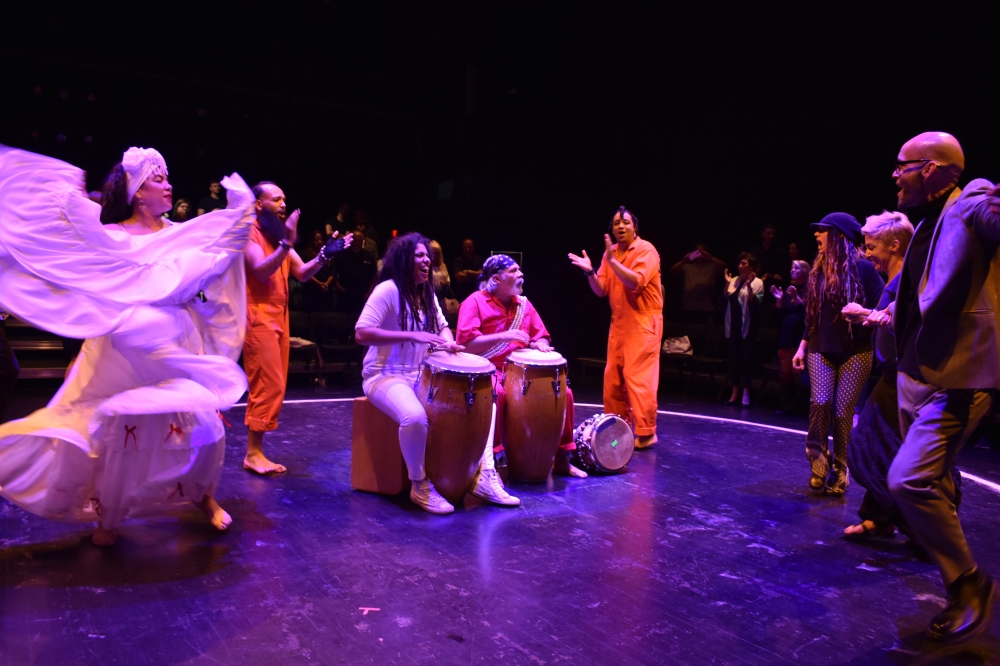Amal, the name of the ferocious theater piece from the Combat Hippies which I saw last Friday, means “hope” in Arabic. And this riveting, authentic original work supplies that in all kinds of ways.

Combat Hippies and Amal are the latest creations from Teo Castellanos, the theater artist and teacher/mentor who, despite numerous awards and powerful, original works, doesn’t get the credit he deserves as one of Miami’s cultural pillars. The Combat Hippies are a small group – three in this show – that grew out of a 2015 MDC Live Arts project with military veterans, including a writing workshop led by Castellanos. He’s continued to teach and lead them under the aegis of the MDC Live Arts Lab, and they’ve done several pieces.

With Amal, the Combat Hippies show that they’ve become a powerfully expressive ensemble – drawing on raw emotion, devastating experience and an uninhibited political point of view that comes from having lived with the consequences of our country’s exercise of power. Because Castellanos leads them, this is channeled through vivid writing and superb theatrical craft, to reach an unexpected, dizzying grace. Amal could stand proudly on any stage in the world.

Hope is an unexpected outcome of this often brutal – though darkly funny – piece, presented at the Black Box at Miami-Dade County Auditorium. Castellanos, executive director/writer/performer Anthony Torres Jr, writer/performer Hipolito Arriaga, and percussionist/performer Angel R. Rodriguez Sr., are all Puerto Rican. In Amal, the performers – the kind of working guys whose battles don’t usually make it to the stage – connect their experiences fighting other brown people in Iraq and Vietnam with the history of the oppression Puerto Ricans have endured on the island and the mainland of a country that, too often, still doesn’t quite accept them as ‘real’ Americans.

Castellanos sets this as true theater-in-the-round. The audience sat around a chalk circle, with Rodriguez at the center, spinning on a stool to play congas and other percussion, as Torres and Arriaga wheel counter-clockwise – the direction of a hurricane – around him, whirling in their own circles to face us. The effect is kinetic and vertiginous – the performers spin us up with them. Designer Karelle Levy puts them in orange prisoner jumpsuits, with the words “colonialism” and “war” punk-pinned with safety pins on their backs. Seth “Brimstone” Schere created the thundering, raucous punk-rap-percussion score, and Gary Lund the stark, dramatic lighting.
The men tell of their fear and confusion in Iraq, struggling to know what to think of men who, like Puerto Ricans after Hurricane Maria or fighting in a revolt on the island, are brutalized refugees in their own country. “Our people have been a people since long before we the people,” they proclaim. “I wanted to hate them,” says Torres, who was a medical worker at Abu Ghraib. “But empathy was part of my job description.” Wrestling with why he joined the army, Arriaga mutters that “crawling through mud ain’t shit compared to being up to my neck in debt.”

The white-haired Rodriguez tells of sleeping in graveyards in Vietnam because they were the only place where the enemy wouldn’t attack. “I was sleeping with the dead to stay alive” he says – and the others chime in with the disco chorus of “Staying Alive.” That’s one example of the black humor that keeps Amal, and the horrendous situations it evokes, from becoming overwhelming. So was a sequence with Rodriguez as a heroin dealer named Body Bag, with Torres and Arriaga as junkies mocking themselves and each other.
Is Amal hopeful? It doesn’t predict a bright future, or let go of its rage. But the piece and the performers find energy and will in each other, and in telling us their story, and in a fight that continues off the battlefield. And in the heartfelt response of the audience, who stood cheering for Amal.

(Lead photo also by Teajay Smith.)

6 Comments Add yours